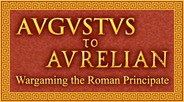I've just started work on a Viking warband for Saga. Primed and with the chainmail and flesh painted, I'm sitting looking at them, a wee bit stuck. I know what colours I'll use for most things - similar, in essence, to the Romans, Britons and Sassanids that have gone before. But two things are giving me pause for thought.
Romans and Britons (and Romans and Sassanids) look quite different to each other - there's no chance of confusing them in the heat of battle. Add to that a few tricks with colours, and the armies appear different, but as though they belong together. First of all, virtually all my Romans have some red on them, but almost none of my Britons or Sassanids do. That creates an obvious difference. There are some colours which I deliberately make the same across all figures - such as using Citadel 'Bestial Brown' for belts, and Wargames Foundry 'Gold' 36B for all bronze. Not very realistic, I admit, but it ties the armies together, somehow.
So, now I'm painting Vikings and Anglo-Danes (Saxons?). Okay, so some Saxons wear silly 'phrygian' caps. Other than that, I'm struggling to spot any big differences in appearances. Bit of a nuisance that, in a skirmish game. I don't want to sink to the 'gamey' level of using different base-edge colours to differentiate them - I think that'd look awful. So what to do? Maybe, given that I'm using Steve Hales (Little Big Men Studios) 'Jomsviking' shield and banner transfers for my Vikings, I should paint each Viking figure with one red item of clothing, and not worry about the Saxon 'rabble'. Perhaps some Viking Jarl has a thing about red, and you can only join his long-ship if you're prepared to wear red... What do you think? I'm not sure that 'works' for peasants/thralls, who I'd be expecting to 'dress' in very subdued, natural, tones. I think I'll stick to painting belts, sword scabbards, and stuff like that in the same colours, so the figures look as though they're from the same 'world'.
Now basing. It has to be said that, as I wander around the world wide web, like some latter-day Flying Dutchman, I notice things. One is that, on average, the basing of wargames figures has improved markedly in recent years - people are much more savvy with how to produce nice bases, aided by various products, like the tufts made by Silflor and others. But I'm far from sure that this has actually improved the appearance of demo games at shows - in fact, it may have had the opposite effect. How so?
One thing many gamers never seem to stop to consider is consistency. A figure base, finished in the modern manner - grit/sand, washed, drybrushed, and enhanced with blobs of static grass and tufts, sticks out like the proverbial sore thumb on the typical wargames table - consisting, as it does, of either TSS boards covered in static grass, or home-made with dry-brushed cat litter and sand. In that regard, older methods, with arguably less 'flashy-looking' bases, were, perhaps, better - they didn't stick out so obviously.
I reckon wargamers should start to think about the 'whole package', and about adopting a 'unified basing scheme' which encompasses their terrain boards, figure bases, and moveable scenery. It doesn't have to be complicated! Take, for instance, my 'desert' set-up. I use an 'under-cloth' - chosen so its colour matched my basing scheme fairly closely, and I enhanced that by adding 'blobs' of the same Woodland Scenics 'turf' as I use on the bases of my figures and terrain. So the effect, though simple, is one where the figure bases don't 'stand out' as being markedly different to the rest of the 'ground'. I think it 'works'.
